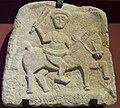English: One of some stelae of promise. Also called kakosbos, these stelae were used as a means of keeping one’s promis to the gods upon the realization of a wish. In general they show a horseman, holding the club of Hercules, riding to the right. On their pedestal the nature of the wish, name of the person who had the wish, and the name of the god to whom was vowed are inscribed.
Note: I take great care in speclling names correctly. For all I know the museum at the time I took the picture spelled "kakosbos", however, I have come across other spellings, and the Wikipedia refers to "kakasbos". To keep in line with that I use that for a name of this picture.
In various museums of this pacific province of the Empire there are votive stele of cavalrymen, with conical caps according to the Hellenic style (Telmessos, today Fethiye). They wear short practical tunics, sometimes folded and padded (Antalya museum), only the belt revealing their military status. Some of them are bareheaded, but some of them are interestingly armed with a club (Telmessos), and wearing a military sagum with a long sleeved tunic. The stele of the cavalrymen Kakasvos and others show the employment of the mace together with the muscled armour, fitted with two ranges of Pteryges. One of them shows a zona militaris knotted around the armour. These stelae were used as a means of keeping one’s promise to the gods upon the realization of a wish. In general they show the donor like horseman, holding the club of Herakles, riding to the right. On their pedestal the nature of the wish, name of the person who had the wish, and the name of the god to whom they were dedicated are inscribed. Some of inscriptions are thanking the god Zeus for the help received in war. The fact that they all are using the club of Herakles does not mean that the image of the club was only devotional. The ravdos or staff was an effective weapon used by paramilitary corps or local diogmitai, to probably the donors belonged. Also the horse presents the typical bunch over the head, made with his mane, typical of many military horses. The horse of the cavalryman Artemon presents a combination of small phalerae and muzzle on his head





 French
French Deutsch
Deutsch